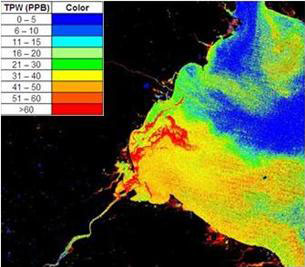Detecting Airborne Cyanobacteria Toxins
3There are many ways to measure the concentrations of cyanobacteria in water, be it with specialized sensors or through discrete sampling and lab analysis. And since water is where the bacteria are produced, this makes sense. But for the toxins that they sometimes make, it’s a different story.
For some time, there have been conversations questioning the possibility of these cyanobacterial toxins aerating, or becoming part of the air surrounding their sources in the form of mist or sloshed-up water. Is there a danger of breathing in the toxins, and how would you go about measuring them anyway?

Algae and cyanobacteria color Lake Erie a bright green in this photo taken from a research vessel on July 21, 2014. (Credit: Sarah Page / University of Michigan)
A new study led by scientists at the University of New Hampshire sets out to answer those questions. Its findings, published in the journal Aerobiologia, lay out a new, low-cost method for detecting airborne cyanobacterial toxins around lakes. Inventing the method builds on previous work that the researchers have done to confirm that cyanobacteria aerosols pose a risk to those living or vacationing near algae-filled bodies of water.
At the center of the method is a portable system that sits on a lake and collects aerosols directly from air nearby. This uses sophisticated air filters to gather samples of small, airborne particles such as photosynthetic picoplankton. It then uses epifluorescence microscopy and excitation filters to distinguish cyanobacteria constituents from other photosynthetic cells by looking at chlorophyll-a and phycobilin.
As proof of the method’s effectiveness, researchers point to the resolution of the concentrations they’ve been able to detect: airborne cyanobacteria (picocyanobacteria), 8872 to 167,297 cells per cubic meter in the field and 23,764 to 365,011 cells per cubic meter in the lab. For microcystin, scientists found levels in the field air filters that ranged from less than 13 picograms to 384 per cubic meter.

Lake Erie algal bloom, August 2014. (Credit: NASA Earth Observatory)
Researchers say that the approach to monitoring the aerosols is important given growing knowledge of the roles that they play in spreading cyanobacterial toxins. In one example, U. of New Hampshire scientists found that there were detectable levels of microcystins in blueberries grown near a lake with persistent algae issues. The blueberry crops hadn’t been irrigated by the lake’s water, but were simply located close by.
Since aerosols may provide a more direct route of exposure for those nearby when compared to their waterborne counterparts, the new detection method could prove useful for reducing risks to public health caused by airborne cyanobacterial toxins in the future.
Do you think airborne cyanobacteria toxins are a big problem? What are some ways to approach treating them? Please consider leaving a comment to share your thoughts!














Yes! I believe airborne Cyanobacteria toxins and byproducts are a problem and that they have been understudied, along with chronic exposure.
Inhalation of Cyanobacteria toxins seems to be a more direct route to the brain and nervous system than that of skin exposure.
In the Southwest Florida epidemic, I believe Cyanobacteria are making the local population ill through exposure to aerosol due to evaporation, waves breaking, and wind currents. This is anecdotal, of course, but it my belief that those within ten miles may suffer mild, intermittent symptoms and that those living on the coast or within 3> miles of affected water bodies have a high incidence of regular exposure.
I live a mile from Lake Erie and have health issues, is there a way to protect my indoor air quality from airborne Cyanobacteria? Will a certain home filtration system with us light remove the smaller particles that become airborne? Will a water purification system remove from drinking water? Would a mask in public help? Lastly, is there a binder or something one could take to get rid of anything inhaled?
Donna I have the experience of driving or camping near stock ponds or reservoirs with scums and feeling my neck become stiff and pop and swelling of ankles. I have also ingested water from a creek in Yellowstone Park that was clear but had green stuff growing on bottom and my heart began to race. So I think these have an immediate effect. One group of doctors that addresses these kinds of cyanobacteria biotoxins is found on Survivingmold.com. I think once your body is compromised it’s really difficult to stay near the body of water. Binder used in my treatment is cholestyramine which traps the toxins as they circulate in bile. Has been used for dogs too.